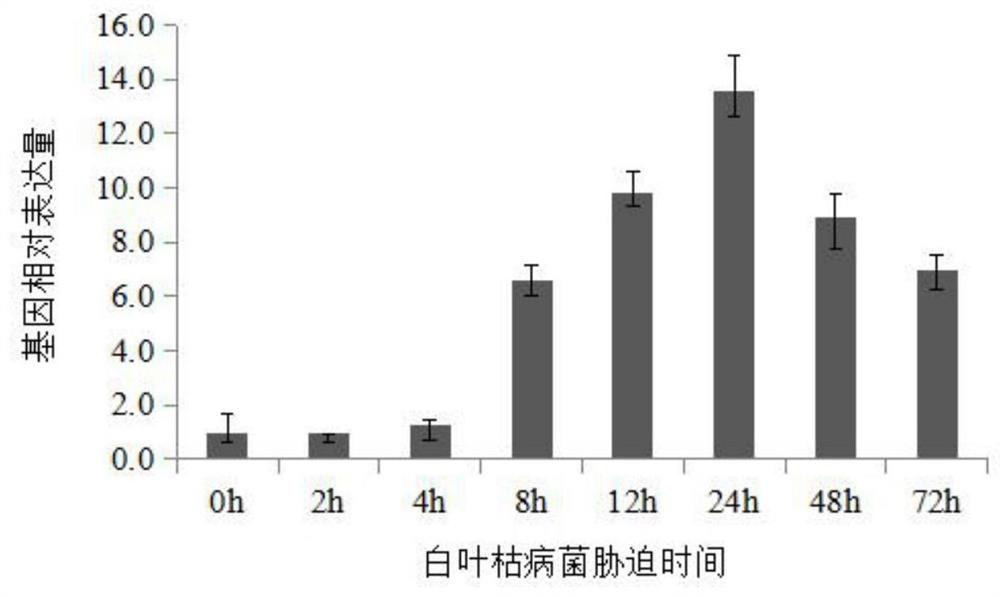Rice MeRING29 gene, coding protein, recombinant vector and application
A recombinant vector and gene technology, applied in the field of genetic engineering, can solve the problems of decreased resistance, complex disease resistance mechanism, frequent variation of physiological races of pathogenic bacteria, etc.
- Summary
- Abstract
- Description
- Claims
- Application Information
AI Technical Summary
Problems solved by technology
Method used
Image
Examples
Embodiment 1
[0045] Cloning of the MeRING29 gene
[0046] The transcriptome sequencing of wild rice verruca yunnanensis was carried out by Beijing Baimaike Biotechnology Co., Ltd., and a gene fragment annotated as Arabidopsis ubiquitin ligase was screened and published in NCBI (http: / / www.ncbi.nlm.gov) Blast comparison analysis was carried out on the Internet, and the gene sequence (shown in SEQ ID No.3) with a homology of 91.5% to the rice gene was obtained, and then according to the sequence screened by this section, through the RACE method (see Beijing Jumei Biotechnology Co., Ltd. disclosed kit operation manual) to obtain the gene for improving rice disease resistance according to the present invention, its nucleotide sequence is as shown in SEQ ID No.1 in the sequence listing, and the amino acid sequence of the protein encoded by it is as SEQ ID No .2 shown. Design specific primers according to the nucleotide sequence shown in SEQ ID No.3, RING-GSP1:5'-GCGAGGGAGTGGCCGGTGGAGTGC-3'(SEQ...
Embodiment 2
[0057] Functional Analysis of MeRING29 Gene
[0058] (1) Bacteria blight and exogenous hormone treatment of wild rice verruca in Yunnan
[0059] Use NA medium to activate bacterial blight pathogen Y8. Y8 is a highly pathogenic physiological race in Yunnan, provided by the Institute of Biotechnology and Germplasm Resources, Yunnan Academy of Agricultural Sciences, cultured in the dark at 28°C for 3 days, and washed with 5 mL of sterile water first. bacterial lawn, and then continue to add sterile water until OD 600 =0.6, the prepared bacterial solution was used to inoculate the leaves of O. yunnanensis at the booting stage. When the greenhouse temperature rises to 28°C, use scissors to pick up the prepared bacterial solution and cut off the top 1.0cm of the leaves of the wild rice verruca yunnanensis with normal growth and no obvious wounds as the infection treatment. The control group is inoculated with sterile water instead of the bacterial solution After the inoculation gr...
Embodiment 3
[0072] Application of MeRING29 gene in enhancing rice resistance to bacterial blight
[0073] (1) Construction of expression vector for overexpression of MeRING29 gene
[0074] According to the full-length cDNA sequence of MeRING29, primers containing a complete open reading frame (ORF) were designed, and a restriction endonuclease NcoI restriction endonuclease NcoI restriction site was added to the upstream primer MeRING29-OF of the ORF sequence of MeRING29 during design. The sequence is shown in the table as SEQ ID NO.8 shows: 5'-CCCATGGATGCCGACGCCTCGCCGCCAC-3', the ORF sequence of MeRING29. The downstream primer MeRING29-OR adds the restriction endonuclease BglII restriction endonuclease site sequence as shown in SEQ ID NO.9 in the table: 5 '-GAAGATCTTTCAAACTTGCCGAGCGATTG-3', using MeRING29-OF and MeRING29-OR as primers, the full-length cDNA sequence of MeRING29 was amplified by conventional PCR and gel recovery, and the PCR amplification product and the vector pCAMBIA2301 ...
PUM
| Property | Measurement | Unit |
|---|---|---|
| molecular weight | aaaaa | aaaaa |
| length | aaaaa | aaaaa |
| length | aaaaa | aaaaa |
Abstract
Description
Claims
Application Information
 Login to View More
Login to View More - R&D
- Intellectual Property
- Life Sciences
- Materials
- Tech Scout
- Unparalleled Data Quality
- Higher Quality Content
- 60% Fewer Hallucinations
Browse by: Latest US Patents, China's latest patents, Technical Efficacy Thesaurus, Application Domain, Technology Topic, Popular Technical Reports.
© 2025 PatSnap. All rights reserved.Legal|Privacy policy|Modern Slavery Act Transparency Statement|Sitemap|About US| Contact US: help@patsnap.com



